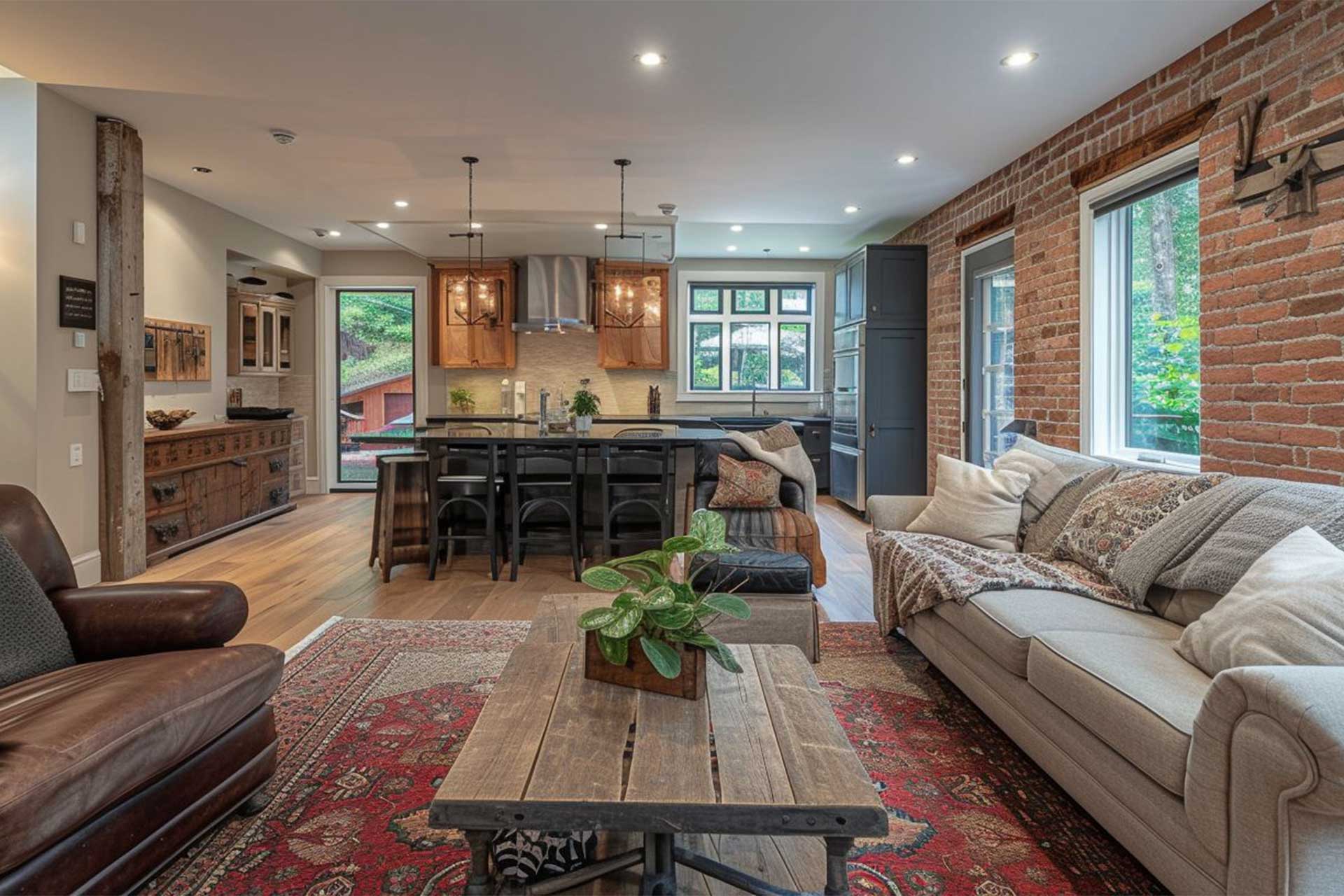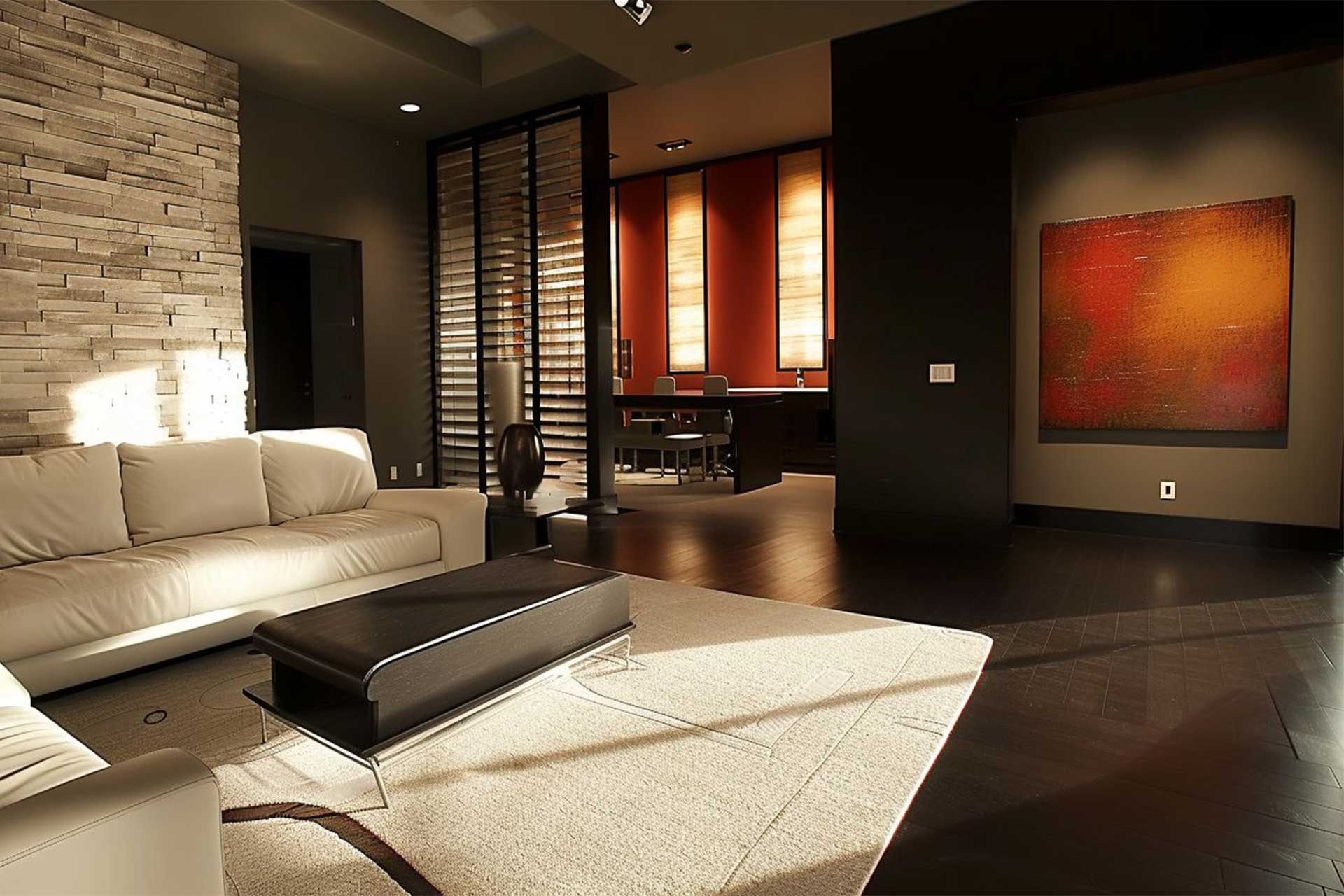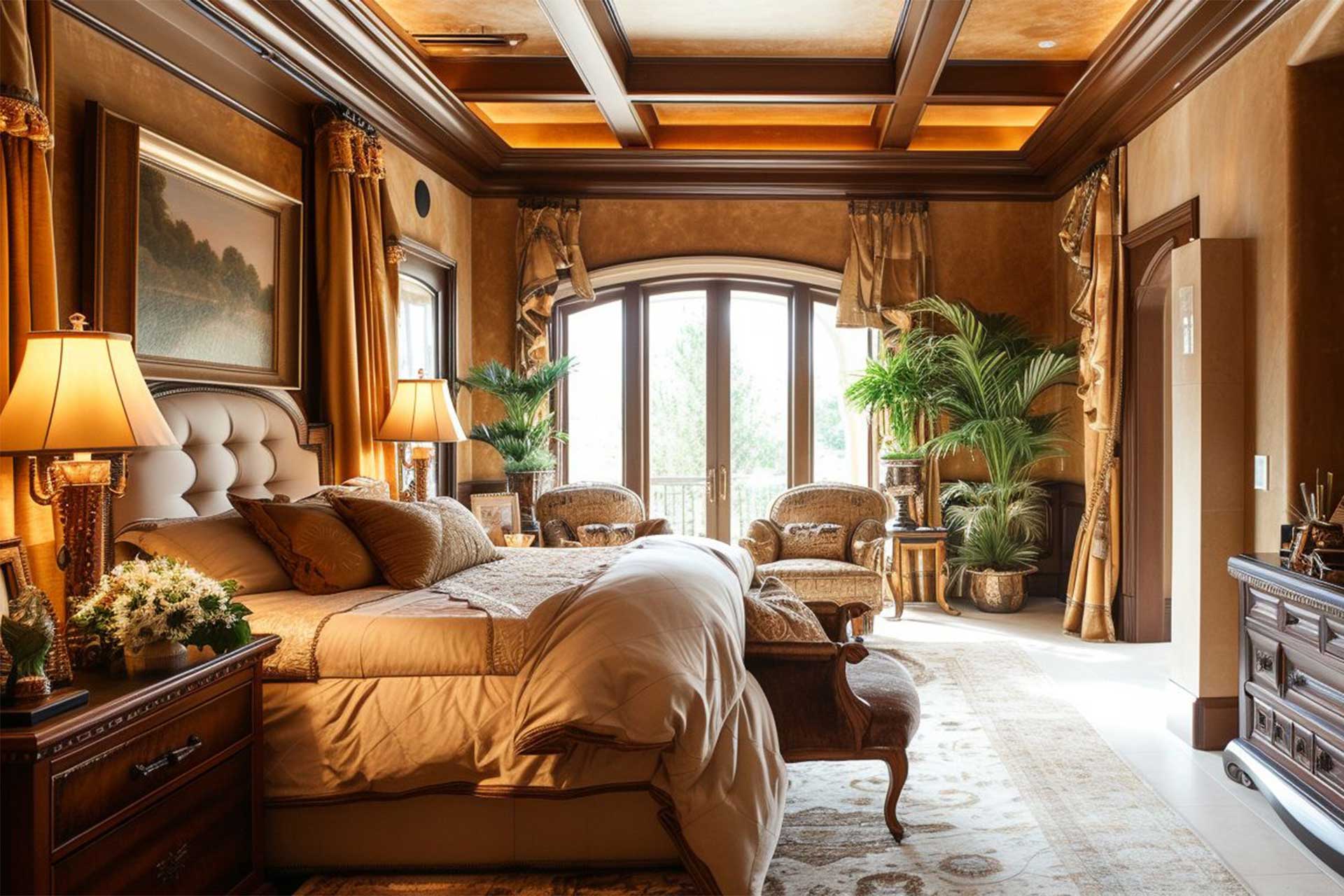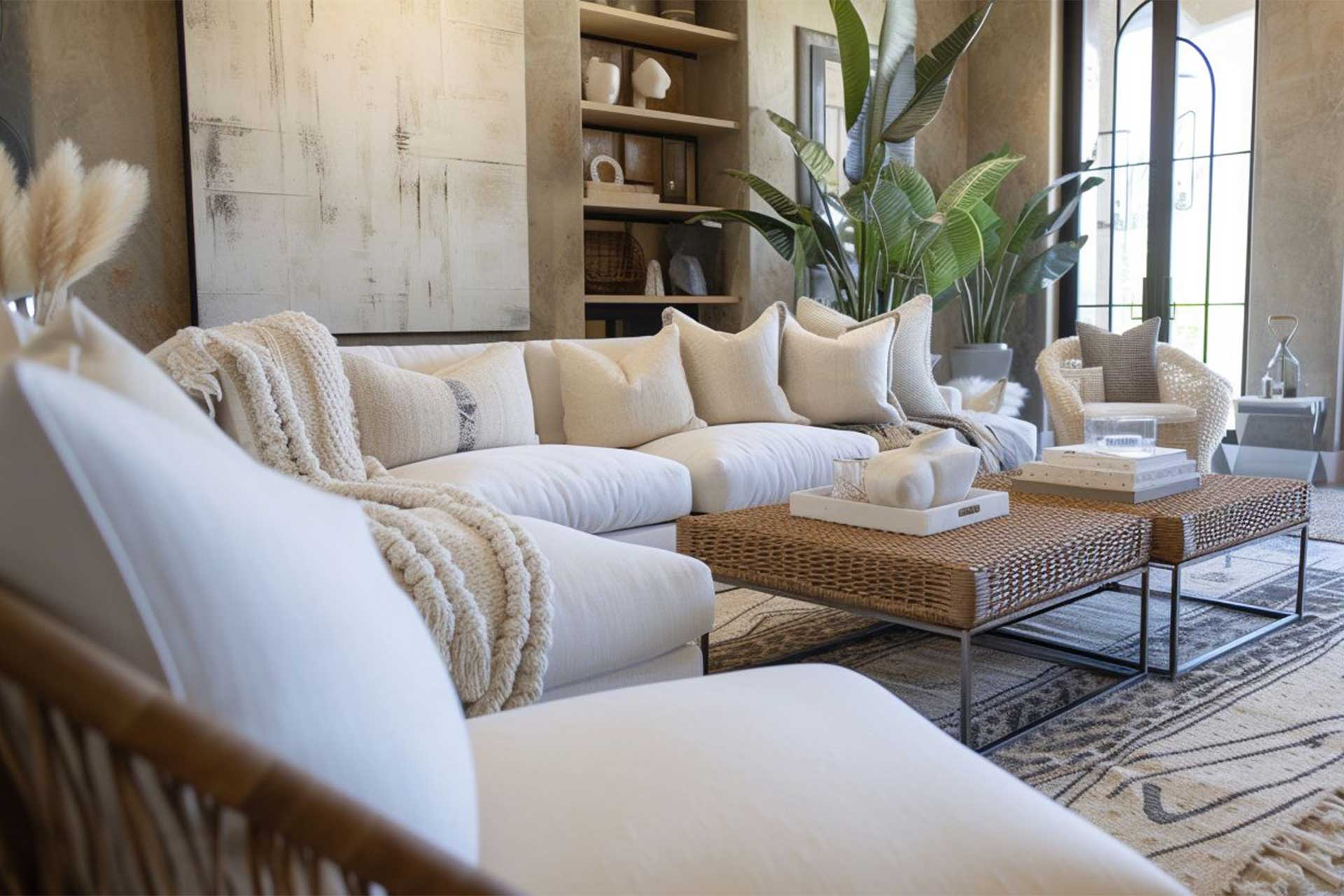
Changing the color or texture of walls in a room can be transformative. It’s also one of the easiest ways to update or elevate a space. However, choosing the right color, sheen, or texture isn’t a thoughtless task. With so many options available, what will work best? The decision between choosing just the right paint sheen, exploring the intricate world of faux finishes, or embracing cozy textiles can feel overwhelming.
We’ve been there – standing in the paint aisle under stark fluorescent light, puzzling over words like “semi-gloss” and “eggshell,” trying to decipher which will work best. Are there right and wrong choices here? Do finishes and sheens even matter?
Yes, they absolutely do, and we’re here to help. Discovering that eggshell paints aren’t just curiously named but actually possess a resilience fit for bustling areas was part of our journey as well.
With decades of research and hands-on experience, we’re here to clear up any confusion around paint sheens and faux finishes by sharing our professional expertise.
Today’s post unravels it all, from choosing the ideal gloss level that makes your sun-drenched living room shimmer to handpicking rich textures that wrap your private oasis in allure and warmth. With our help, you can confidently make the right choice for your space, transforming walls from mundane to magnificent!
So, keep reading to learn how the right wall finishes can transform a room and create praise-worthy spaces that ooze personality and charm.
Key Takeaways
- A paint sheen indicates the shine of the paint. From no-shine flats to high-gloss, pick sheens based on room use and cleaning needs.
- Faux finishes like Venetian plaster or metallic paint make walls look fancy without much cost.
- Textured wallpapers or paints add depth and hide wall marks, quickly changing a room’s feel.
- Dark colors need careful sheen consideration to avoid too much shine. Semi-gloss often strikes the right balance.
- Textiles in design give rooms warmth and comfort, mixing patterns for an interesting space.
Understanding Paint Sheen, Faux Finishes, and Textiles
Let’s demystify the world of finishes and textures by unraveling the secrets behind paint sheen, faux techniques, and touchable textiles. Whether you want to bring a subtle glow or add dramatic flair, we have the know-how to guide your choice.

Different Types of Paint Sheens
When selecting the right paint sheen, the first step is to consider the look and durability wanted and needed for the space. Paint sheens range from flat to high gloss, each with its own qualities.
- Flat (or matte) finish: This kind of paint has a non-reflective finish that is good for hiding small wall bumps, cracks, and other imperfections.
- Matte paint: Similar to a flat finish, matte paint provides a minimal sheen, ideal for rooms where you want a soft, velvety look.
- Eggshell finish: It has a low-sheen and pearl-like appearance that works well in living rooms or bedrooms.
- Satin paint: This interior paint sheen gives walls a soft glow that’s easy to clean, making it perfect for high-traffic areas like hallways.
- Semi-gloss finish: Semi-glosses are shiny but not overpowering. They are great in kitchens or bathrooms because they handle moisture well.
- High gloss: The highest level of shine available, this glass-like finish is very durable and makes surfaces like woodwork or kitchen cabinets pop.
Characteristics of Each Sheen
Now, let’s consider the characteristics of each sheen. Paint sheen refers to the glossiness of a paint finish, and understanding this will guide you in creating the perfect ambiance for any room.
Each sheen brings a unique texture and function to the wall it covers. For instance, high glosses are unmatched in durability and ease of cleaning; their light-reflecting properties are perfect for spaces that require frequent wipe-downs.
Semi-gloss finishes follow closely, lending a sleek radiance to kitchens and bathrooms without the intensity of high gloss. Satin sheens offer us a versatile, easy-to-maintain surface with a soft glow, ideal for those bustling traffic areas.
Select eggshell for its delicate luster that hides imperfections and provides an elegant finish for social spaces. Flats, with their non-reflective nature, can create a sophisticated and understated look. Although they demand more care, they are excellent for areas less prone to dirty hands and scuff marks.
Choosing the Right Paint Sheen

When choosing the right paint sheen for your space, it’s best to let the function and foot traffic of a room guide your decision. It’s all about striking that perfect balance between practicality and aesthetic appeal.
Consider the Room’s Purpose and Traffic
Think about how each room is used before picking a paint finish. If you have kids or pets running around, something that stands up to cleaning, like high-gloss paint in hallways and kitchens, is best.
These areas get messy fast, but glossy walls make it easy to wipe away scuffs and fingerprints.
In living rooms or bedrooms with less hustle and bustle, eggshell or satin finishes are perfect. They have a soft glow that hides imperfections better than matte finishes.
Less sheen means less spotlight on bumps and nicks. For the ceiling, go for flat paints – they’re great at hiding sheetrock tape joints and nail pops with their non-reflective surfaces.
And remember, dark colors need careful sheen choices to avoid being too shiny; semi-gloss strikes the right balance here.
How to Balance Sheen With Color
Choosing the right paint finishes also means matching sheen to color. It’s best to opt for high glosses with lighter colors to make rooms feel brighter and more reflective. When dealing with dark colors, go for less shine to keep them from looking too glossy – and steer clear of flat finishes because they can lead to chalking.
Eggshell or satin are our middle-of-the-road picks; their pearl-like luster brings durability and easy cleaning, perfect for walls in busy spots.
Also, think about the room’s vibe when balancing sheen and color. For a softer look, matte paints do the trick. However, remember that although they hide application flaws well, they aren’t as easy to clean. Semi-gloss gives that sleek, radiant appearance without being overwhelming, and they are just right for kitchen or bathroom walls where moisture is commonplace.
To sum it up, it’s all about picking a paint finish that complements your chosen hue and meets the needs of each space in our homes.
Special Considerations for Dark Colors
Dark colors are tricky. They look rich and deep, which is great, but they can get too shiny if you’re not careful. If you select a sheen that’s too high, the walls might look overly glossy. So, it’s best to pick a sheen level that’s just right to keep the elegance without the glare.
Also, steer clear of flat finishes for dark hues because they don’t hold up well over time. Without some glossiness, dark-painted surfaces can show chalking, which is when the paint starts to break down and leave a powdery residue.
The goal is to have walls that look good today and years from now, so choose a finish that lasts and looks perfect in any light.
Exploring Faux Finishes

Faux finishes embrace an artistic touch that can transform any space. When considering these finishes, it’s about experimenting with techniques and materials to craft walls that tell a story or mimic textures from nature.
Different Types of Faux Finishes
We love making homes beautiful with different paints and finishes, and there are so many amazing looks that can be achieved. Here’s a quick tutorial on popular faux finishes.
- Venetian Plaster: This technique gives walls a rich texture that looks smooth. Venetian plaster mimics the look of marble or stone, adding elegance to any room.
- Metallic Paint: When you want your walls to sparkle and catch the light, go for metallic paint. It makes spaces feel more open by reflecting light around the room.
- Suede Finish: Suede finish is perfect for a soft, touchable look. It adds a velvety texture to your walls that feels cozy and inviting.
- Color Washing: This style uses a soft brush to apply a thin glaze over a base coat, creating subtle layers of color. It’s like an artist’s work right on your wall!
- Rag Rolling: Using rags to roll glaze onto the walls offers a rustic, textured effect. This finish adds depth and movement through its unique patterns.
- Strié Technique: This involves dragging a brush through the wet glaze to create fine lines that mimic linen or silk on your walls. Elegant and timeless!
- Wood Graining: To achieve a wood-like finish with hammers and nails, this technique uses paint to imitate various wood patterns, bringing nature’s beauty indoors.
- Marbleizing: Paint can replicate real marble’s intricate veins and swirls. This luxurious finish adds opulence to interior walls without breaking the bank.
Creating Different Effects With Faux Finishes
Faux finishes can transform a plain wall into a work of art. They mimic the look of expensive materials like marble, stone, or wood without the high cost. You can choose a rustic style for a cozy cabin feel, opt for Venetian plaster to add rich texture, or add authentic-looking old-world charm with plaster.
Shimmering effects are also popular and easy to create with metallic paints. They catch the light and make rooms sparkle. To experience the look of these different finishes, visit the Hester Painting & Decorating showroom, which features over 40 finished walls on display.
Seeing real-life large samples can help you imagine how these faux techniques will look in your own space before making a decision.
Adding Texture with Textiles

Next, let’s explore the world of textiles and how they can introduce a whole new layer of character to your spaces. Imagine transforming a room not just through color but also through the rich dimension and inviting warmth that fabrics offer – it’s truly taking wall design to another level.
Using Textured Wallpapers or Paints
We love bringing life to rooms with textured wallpapers and paints. They add depth, warmth, and artistic flair. Here are some tips for perfecting the look.
- Choose textured wallpaper for easy application. It hides imperfections in the walls and brings a cozy feel to any space.
- Pick paint with built-in texture for a custom look. You can create patterns like stucco or sand swirls on your walls.
- Consider the room’s style before choosing a texture. A modern look might need smooth textures, while a rustic style goes well with rougher ones.
- Combine textures with colors for unique effects. Dark hues can make spaces feel smaller, but a light texture can balance this effect.
- Textured paints are great for hiding small dings or scratches on walls. They’re also more forgiving when it comes to touch-ups down the line.
- Visit our showroom in Skokie, IL to see over 40 full-size walls with different finishes. Seeing large samples in person helps you decide what you like best.
Benefits of Adding Textures to a Room
Textures with textiles are a budget-friendly way to bring beauty to rooms. They wrap walls and furniture in layers of tactility, adding cozy warmth that invites people in. These clever design touches mix patterns and materials to create a dynamic look.
In each room, textiles can introduce contrast, making artwork pop or giving life to dull corners. They elevate a room’s feel with artistic flair – think plush velvets or rough linens – and offer visual interest that ties everything together.
Adding textures means crafting an environment where every glance holds something new to discover.
Conclusion
We’ve looked at paint sheens, faux finishes, and textiles to add style on a budget, including how to match the paint’s shine to its use and look. Remember, high gloss means easy cleaning and flat hides flaws best.
With faux finishes like Venetian plaster or metallic paints, you can mimic many breathtaking looks – and textiles bring comfort and depth to walls with less effort. Now, go forth and transform your home with these smart choices today!
For stunning, professional interior painting in the Chicago area, contact Hester Painting & Decorating today!
FAQs
1. How do I choose the right paint sheen for my room?
You can use a paint and stain calculator to find the best exterior or interior paint sheens for your spaces.
2. What should I know about faux finishes on walls?
Faux finishes add unique textures to your walls, making them stand out. It’s like adding special effects with paint!
3. Can textiles change the feel of my room?
Yes, choosing different textiles for curtains or upholstery can totally transform your space with new colors and patterns.
